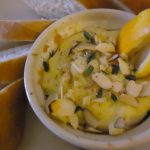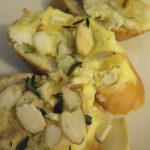This post is courtesy of Patrice Johnson, friend of Ingebretsen’s and valued guest blogger. Enjoy!

Minnesota was once host to several smörgåsbord restaurants before 1970s trends changed the supper club and dining scene. Remember the Jolly Troll? I don’t remember the food or the buffet, but I do recall pressing my nose up against the glass to watch the animated trolls that served as the décor.
Smörgåsbord translates to “sandwich table” or “bread and butter table” and is the obese grandchild of a fashionable grandmother known as the brännvinsbord (the burning wine table or spirits table). In the 1700s the brännvinsbord was popular with wealthy Swedes who served the appetizer buffet before elaborate banquets. The table was laden with bread and butter, salted and cured fish, meat, cheese, beer and aquavit. Guests served themselves and stood as they ate, drank, and socialized.
During the 16th and 17th Centuries it became common to present all food to be served during the meal on the table upon eating commencement (not unlike what we refer to as service family style). The modern smörgåsbord spread from these customs during the 1880s when travel by train increased as did the need for lodging and public dining. Moreover, new methods in food preservation allowed an abundant feast where out-of-season delicacies appeared alongside seasonal specialties. The popularity of smörgåsbord grew until WWII when, due to food shortages, the government prohibited it. Reinstituted in 1949, several decades passed before the smörgåsbord was again a national activity.
Now that I am an adult I am a stickler for smörgåsbord tradition. There must be a first course table with what I call the big money items: assorted herring dishes, gravlax and poached salmon, shrimps, boiled potatoes with dill, cheese, pickles, bread and crispbread (knäckebröd), all washed down with beer and shots of aquavit. The second course table includes cold dishes such as cold cuts, sausages, ham, pâtés, and salad. The third course table is known as the hot course and often includes meatballs, seasonal roasts, and Jansson’s Temptation (a potato, onion, and sweet anchovy casserole also known as Janssons frestelse). Lingonberries and warm vegetables also make appearances. Beer and aquavit continue to flow until the final table is visited. The final course is a dessert table loaded with an assortment of pastries, cakes, puddings, cookies, fruits, and occasionally cheese. This is also the time for a sobering cup or two of coffee.
(A gentle word on behavior I’ve witnessed at local smörgåsbord events: there are rules to be followed. Please change your plate for each new course. Do not overlap courses. Do not load your plate. As I mentioned, I am a bit of a stickler.)
Brännvinsbord is alive today in that first big money course of smörgåsbord. Often referred to as Smör Ost och Sill Bord (butter, cheese and herring table), this unique spread can make your next brunch or cocktail party fun and unique. An updated SOS table perfect for entertaining and adapts well to seasons.
Spring is coming, I promise, and my spring SOS table will include pickled asparagus and ramps, boiled eggs with lemon and chive mashed yolks and caviar-topped, at least two kinds of pickled herring, gravlax kissed with beets, dilled new potatoes and cucumber salad, cheese and accoutrements, and local beer and Gamle Ode aquavit. The focus of my spring SOS will be small pots of brandade to be spread on good rye bread. The promise of this meal has me powering through lent.
Think of brandade de morue as fish and chips Provencal. Brandade is a puree of reconstituted salted cod, potato, and aromatics. It is especially popular in regions where commercial salt cod is available, such as in the Mediterranean. Home-salted cod is a satisfying substitute, and happily this simple yet glamorous dish plays well with Scandinavian flavors.
Serve the pots hot with bread or crackers or spread the pâté uncooked over crostini, garnish with the almonds and herbs, bake 10 minutes, and then pass a serving tray among your cocktail party guests. For a less formal snack, roll chilled brandade into balls and coat with egg wash and bread crumbs, then fry.
Brandade Recipe
Servings: 12
Ingredients
1 pound cod
1 cup Kosher salt if making your own salt cod.
4 cups almond milk
Zest from two lemons and one orange
Fresh cracked pepper
Three sprigs thyme or dill, plus more for garnish
1 small white onion, chopped
3 cloves garlic, smashed but not minced
1 teaspoon ginger
1 teaspoon cardamom
1/4 teaspoon nutmeg plus more for garnish
1/2 to 3/4 pound russet potatoes, peeled and chopped
1/2 to 3/4 pound Yukon Gold potatoes, peeled and chopped
2 eggs, beaten with 1 tablespoon milk or cream
1/3 cup extra virgin olive oil
Juice from half a lemon
¾ cup sliced almonds
1 lemon, seeded and cut into 12 pieces
1 orange, seeded and cut into 12 pieces
Directions
1. Cover fresh cod completely in salt and refrigerate 24 to 48 hours if making your own salt cod. Soak in clear water if using salt cod. Soak 24 to 48 hours in the refrigerator. Change the water 2 to 3 times.
2. Remove cod from refrigerator and rinse very well with cold water; pat dry with paper towels.
3. Add milk, zest, pepper, thyme or dill, onion, garlic, ginger, cardamom, and nutmeg to bread loaf pan; place in preheated 350 degree oven for 10 minutes. Add cod to hot milk and return to oven. Oven-poach fish for 10 to 12 minutes or until flaky and tender.
4. While cod poaches, cook potatoes in unseasoned water until tender; drain. Push cooled potatoes through ricer or food mill.
5. Remove cod from poaching liquid and cool. Remove any bones and skin; flake flesh as fine as possible.
6. Combine potatoes and cod; add eggs and mix well. Fold in olive oil and lemon juice.
7. Divide mixture evenly into 12 buttered ramekins. Garnish each ramekin with 1 tablespoon of almonds, thyme or dill, and nutmeg. Bake at 325 degrees for 20 to 30 minutes. Serve with lemon and orange wedges and thin slices of toasted bread.
–Patrice Johnson


Sounds delicious, I think my family will like it too – thanks for the recipe! – Anessa